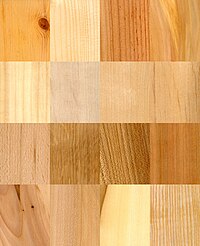
Photo from wikipedia
Abstract This paper describes experimental investigations on timber-concrete composite members made of beech laminated veneer lumber (LVL) with notched connection. Timber-concrete composite slabs represent interesting building solutions, and can substitute… Click to show full abstract
Abstract This paper describes experimental investigations on timber-concrete composite members made of beech laminated veneer lumber (LVL) with notched connection. Timber-concrete composite slabs represent interesting building solutions, and can substitute conventional reinforced concrete slabs and timber slabs. LVL based materials have controllable and homogeneous properties, and allow to exploit the potential of some hardwood species (e.g. beech). The purpose of this experimental work was to validate an analytical model for ductile design of the composite member based on the fact that a plastic compressive failure of LVL within the notches shall be the governing failure mode. The test setup simulated a uniformly distributed vertical load, the specimens were made of beech LVL panels, and the most significant parameters varied in the experiments were the presence and the amount of vertical reinforcement. The test results allowed to validate the design model and showed that the structural behavior of the composite member can be governed by a plastic compressive failure of LVL, and that vertical reinforcement is indispensable to allow development of plasticity. Thanks to the elevated mechanical properties of beech wood, the specimens tested exhibited high strength and stiffness.
Journal Title: Engineering Structures
Year Published: 2017
Link to full text (if available)
Share on Social Media: Sign Up to like & get
recommendations!